- Companies
-
- Admin
- Account Options
- Pricing settings
- PDF and Email Template system preferences
- Locations
- Brand Customisation
- Product Categories
- Product Groups
- Enable Time Billing
- Customising Assets
- Custom Fields
- Delivery Resources
- Delivery Options
- Reporting Preferences
- Sales & purchase settings
- Calendar Settings
- Messaging settings
- Repeated Invoice frequency
- Company Settings
- Credit Settings
- Sales Regions
- Asset Settings
- Ticket settings
- Relationships
- Proposal-based Quotes
- Customising Training
- Prefix/Sequences settings (Record Numbering)
- Creating SMS Templates
- Invoice Settings
- Creating Email Templates
- Creating Letter Templates
- Using Letter Templates
- Using SMS Templates
- Using Email Templates
- Setting up Teams
- System security
- Users
- Activate a new User account
- Log into a User account
- Managing Connections
- Calculating Landed Costs
- Resources
- Payment Methods
- Payment Terms
- Couriers
- PDF Templates
- Service Reports
- Quote Form Templates
- System Quote Preferences
- Credit Control
- Setting up Teams
- Regional Settings
Setting up Teams
Teams in the CRM serve three purposes:
- They are a point of assignment (E.g. “Assign this lead to NSW Sales”).
- They also are used to set team-based security permissions for Users.
- You can add a generic email address to a Team into CRM so that you can send emails using this as a ‘from’ address e.g. you may have email addresses that aren’t specifically linked to a person, like sales@ or info@.
If you invite a User to CRM and they are not attached to a Team, they won’t be able to see or do anything.
You may also be interested in other system security options available in CRM.
Navigate to Admin > Settings > Users, Teams & Security > Manage Teams.
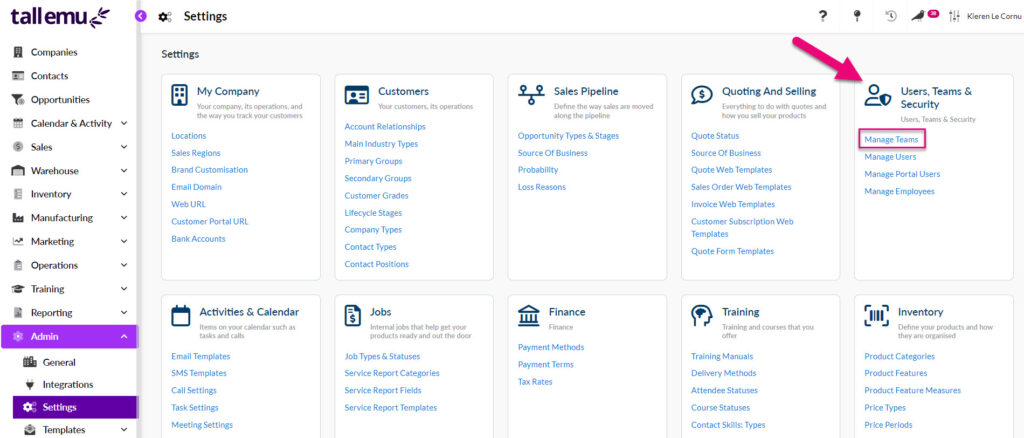
- From this page, you can view existing Teams and add new ones by using the New Team button in the top right corner.

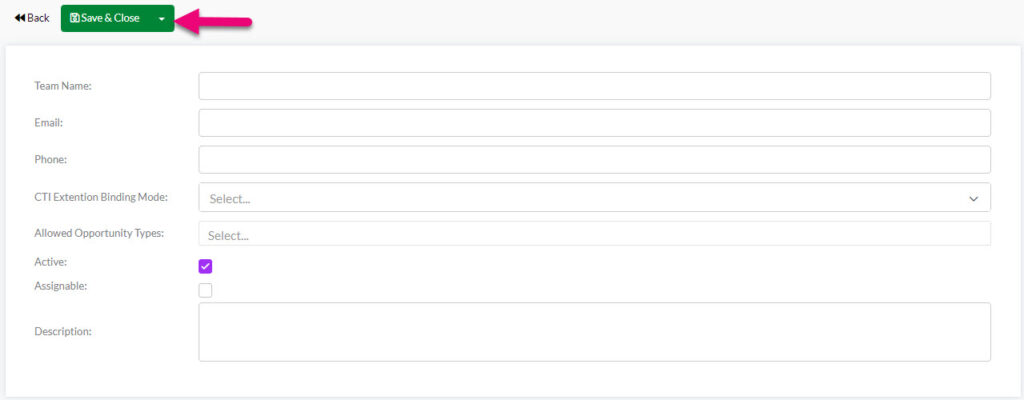
The fields available when creating a new Team have the following purpose:
- Team Name e.g. “Sales team”
- Email – if the group of users has a central email address e.g. [email protected]
- Phone – if the group of users has a central contact number e.g. 1400-111-111
- CTI Extension Binding Mode – this is only required if a phone system is connected to your CRM, so you do not need to complete this field.
- Allowed Opportunity Types – you can customise Opportunities to segment them into different Types. You can then allow Teams to have access to only specified Types.
- Active – for your purposes, this needs to be ticked and you can untick this in future if you want to deactivate a team.
- Assignable – this means that the Team can be assigned to users and users can be assigned to the Team. This box should be ticked.
- Description e.g. this Team is for members of the sales team based in Sydney.
- Ensure that you click Save & Close when you are finished.
- Once you have saved a new Team, you can scroll down the page and see that permissions are broken into groups of functions within CRM e.g. Quoting and Selling, Marketing, Manufacturing etc.
- You can click on the Permission button for any group to expand it and reveal further choices.

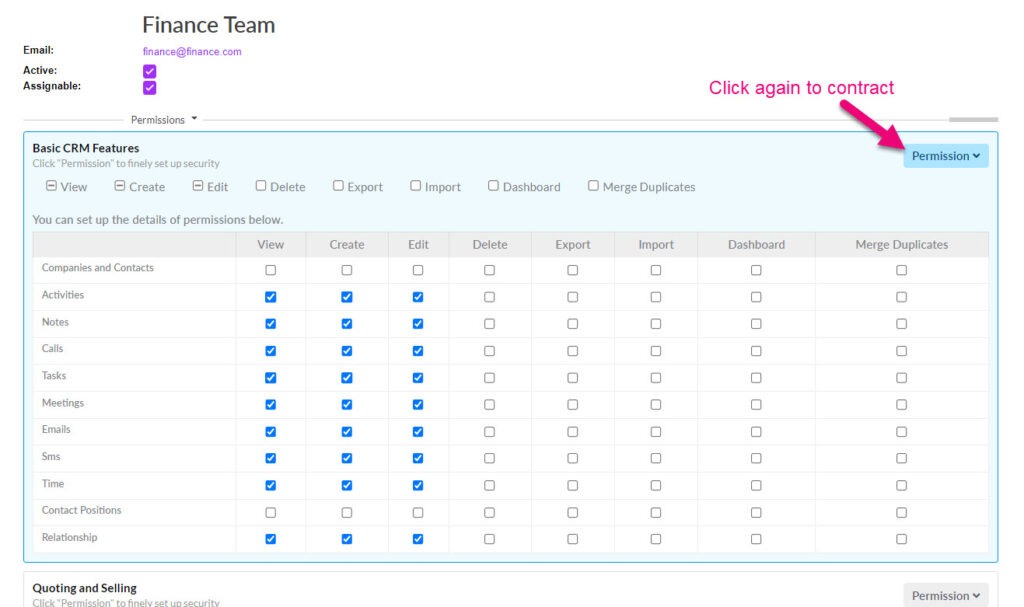
Once you have expanded a group, you will see a number of columns that indicate which types of permission are available and a list of areas in CRM that each permission relates to, as per the following example.

Following is a summary of what each of the available permissions means, using the Sales Team example above, which shows the Team being given permission to perform all actions within in the Opportunities module.
- View – members are able to see the named module e.g. members of the Sales Team example here would all be able to see Opportunities if the View box corresponding with the Opportunities row is ticked. If this box remains unticked, they will not be able to see the module.
- Edit – members are able to edit records within the named module e.g. members of the Sales Team example here would all be able to edit Opportunities if the Edit box corresponding with the Opportunities row is ticked. If this box remains unticked, they will be able to view the records but will not be able to edit them.
- Create – members are able to create new records within the named module e.g. members of the Sales Team example here would all be able to create new Opportunities if the Create box corresponding with the Opportunities row is ticked. If this box remains unticked, they will be able to view and edit existing records but won’t be able to create new records.
- Delete – members are able to create new records within the named module e.g. members of the Sales Team example here would all be able to delete Opportunities records if the Delete box corresponding with the Opportunities row is ticked. If this box remains unticked, they will be able to view, create new and edit existing records, but won’t be able to delete records.
- Export – members are able to export records within the named module to an Excel spreadsheet if the Export box corresponding with the Opportunities row is ticked. If this box remains unticked, they will be able to view, create new, edit and delete existing records, but won’t be able to export them.
- Import – members are able to import new records within the named module by uploading a CSV file if the Import box corresponding with the Opportunities row is ticked. If this box remains unticked, they will be able to view, create new, edit, delete and export existing records, but won’t be able to import them.
- Dashboard – members are able to view Dashboards associated with records within the named module if the Dashboards box corresponding with the Opportunities row is ticked. If this box remains unticked, they will be able to view, create new, edit, delete and import & export existing records, but won’t be able to view the records in Dashboard format.
You can tick each box to grant permission for a particular area of CRM.

You can also quickly tick all the boxes in a column by ticking the master boxes at the top, as per the following example. The reverse is also true: de-selecting the master tick boxes will then de-select all column boxes.

You can then go and de-select any boxes to remove permissions, as per the following example where I have applied all permissions in all columns and then de-selected some.
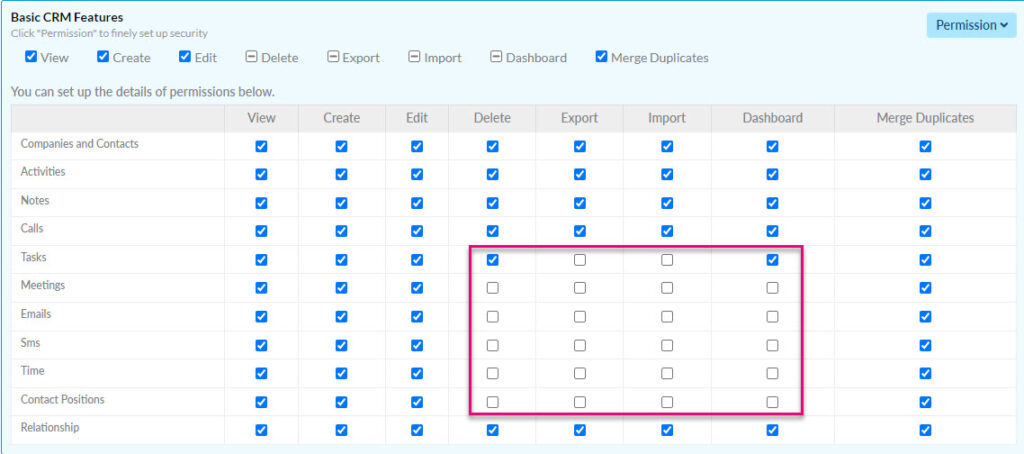
When you have finished applying all permissions, scroll down to the bottom of the page and click on Update to apply your changes.

Once you have saved a new Team, you will be able to see a new area at the bottom of the form where you can add Users as Team members.
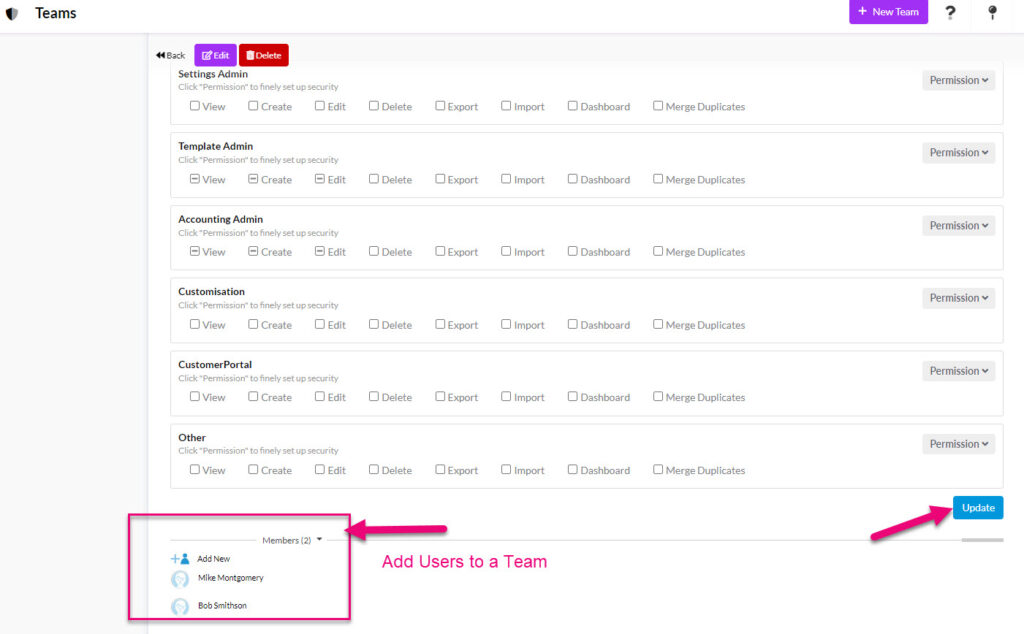
You can also add a person to a Team from their User record. Open the User record, click on Add New and select a Team from the list, then click on Save.
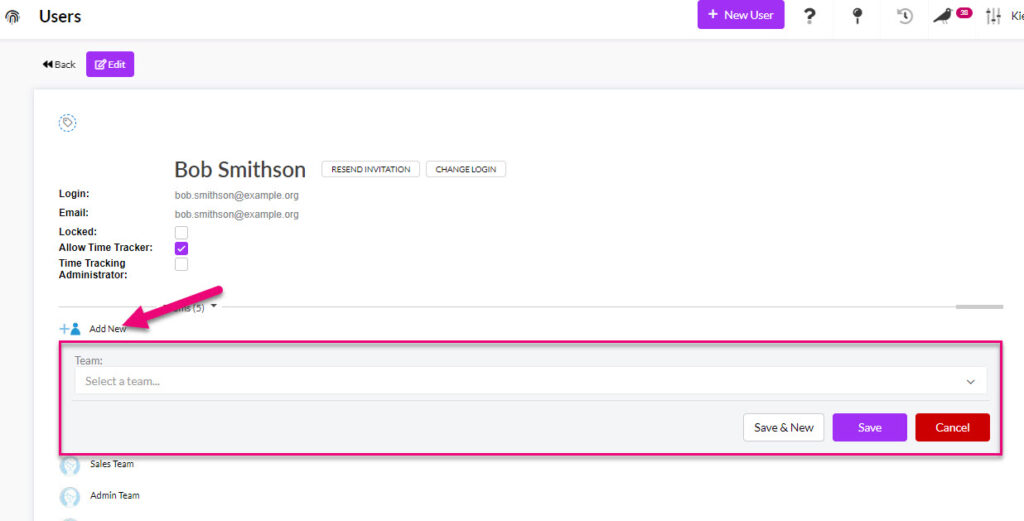
This Team is set up in your system by default. If you add a User to this team they will be able to see everything and do anything in the system.
